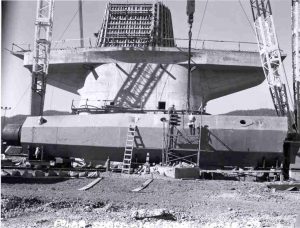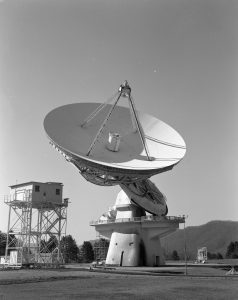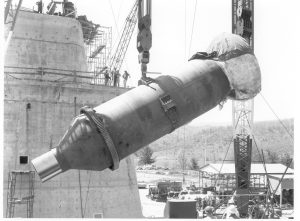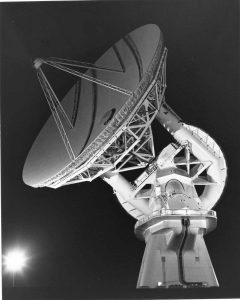The original polar shaft of the 140-foot (43-meter) telescope in Green Bank, West Virginia was a welded steel unit delivered in 1959. A 22-foot wide welded steel bearing was meant to attach to the end to form the spin axis of the telescope; however, small cracks were discovered throughout the sphere. By 1962, and after many heated debates and re-evaluations, these welded steel designs were abandoned. The steel from the sphere was taken to Long Island to shield the particle accelerator at Brookhaven National Laboratory, and this shaft was installed as a culvert under one of the roads at our observatory.


Not Your Average Telescope
This 140-foot aluminum-clad parabolic dish antenna sits on the world’s largest polar-aligned mount. The rounded yoke swivels around the central axis of the telescope which is aligned perfectly with the rotational axes of the Earth. In this way, the 43-meter dish can easily track objects in the sky as they appear to rise and set from the Earth’s spin on its axis. The small white tower to the left is rolled up to the telescope when the dish is lowered to the ground for engineers to work on the prime focus at the tips of the four support legs.

The Last Panel
In December of 1964, the last of 60 aluminum surface panels was installed on the 140-foot (43-meter) telescope in Green Bank, West Virginia.

Talking About Shaft
The polar shaft for the 140-foot (43-meter) telescope in Green Bank, West Virginia is one of two axes for our 200-foot tall telescope. This shaft is a machined, 3.5% nickel steel casting weighing 40 tons, welded to a tubular, rolled plate straight section weighing 90 tons, which in turn is welded to a 3.5% nickel conical transition casting machined to 85 tons. The maximum length is 55 feet and diameter is 12 feet. The world’s largest metal bearing (covered) was bolted to the end using 29 5-inch diameter high strength steel bolts to become the rotational bearing for the telescope. It took six hours to carefully lift and place this 555-ton shaft into its casing on the concrete pedestal.

The 140-foot in 1975
The unique 140-foot (43-meter) telescope shines on a clear night in Green Bank, West Virginia in 1975.

Big Dipper and the 140-foot
The Big Dipper points to the 140-foot (43-meter) aluminum-clad parabolic dish antenna of the world’s largest polar-aligned telescope. The rounded yoke swivels around the central axis of the telescope which is aligned perfectly with the rotational axis of the Earth. For the Northern Hemisphere, that means that the sky (and this telescope) wheels around a point near the North Star, Polaris. In this way, the telescope can easily track objects in the sky as they appear to rise and set from the Earth’s spin on its axis.





